Comments?
For the basics, see
- Website & Privacy Policies
- How To Get Involved
- The Role of the Park
Search options:
Department Site Map
Custodians:
Dufferin Grove Park Newsletter February 2019
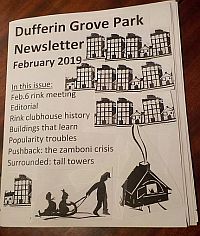 Tall towers everywhere |
This newsletter is put out by CELOS, the Centre for Local Research into Public Space. Since 2000, when this little organization began at Dufferin Grove Park, we’ve been doing what we call “theoretical and practical research” into what makes public spaces – like parks – more hospitable and more lively. We’ve been researching what works and what doesn’t, and we’ve documented a lot of what we’ve seen and done, in the newsletter and on our five websites.
Wednesday Feb.6, 2019, Open house 5.30, Public meeting 6.30 to 8 p.m.
Subject: design plans for the “Northwest Corner Revitalization Project”
St. Wenceslaus Church, 496 Gladstone Ave
From LURA, the city’s consultant in charge of community consultation for this project:
Who is invited: Everyone is welcome to attend. Councillor Ana Bailao, Ward 9 Davenport, will also be attending the meeting.
Details: The meeting will begin at 5:30 pm with an open house. During the open house, participants will be able to browse through project information boards, speak with members of the project team, and leave written comments. At 6:30 pm, following the open house, there will be a 45 minute presentation from the project team, explaining the purpose and background of the project, as well as initial design concepts for improvements to the clubhouse and north-west corner. The presentation will cover everything shared on the project information boards. At 7:15 pm, the community can participate in small group discussions to share their feedback on the various design concepts. These conversations will be facilitated and recorded by members of the project team.”
This meeting is in the new style. Participants will be seated at round tables. After the presentation by DTAH, the design firm hired by the city, each table will be asked to focus on the task of answering specific questions about the five alternative designs proposed by DTAH. There seems to be no point at which people will be raising their concerns to the room as a whole.
This is more like a roomful of focus groups or a class than a public discussion.
The reason for the reno/rebuild: City planners say that the building is old (25 years), the hockey rink should be a few feet wider, the refrigeration machinery could use replacing, and “the city has identified an opportunity” to change the northwest corner of the park. The architectural firm of DTAH has been hired for $700,000 to make the plan and supervise the construction.
Proposals: City staff have allocated $4 million for a complete makeover. There are five possible plans on the table so far. Sample link: Option 2. Three plans involve demolishing the rink clubhouse and rebuilding it to the north or the east of the rink pads. All five plans call for a long hallway with a bench for skate-changing, separated from a “multi-purpose room.” A commercial kitchen with a snack bar counter would be at the end of that hallway. All plans call for the demolition and rebuilding of the two rink pads to get (slightly) different dimensions.
History: the rink clubhouse
Toronto is the world capital of outdoor rinks. We have 53. (New York City has eight, maybe.) Each rink has a building that houses the refrigeration equipment, sometimes a zamboni, one or several change rooms and usually some washrooms.
Like most of these buildings, the Dufferin Rink house was meant to be a three-and-a-half-months-a- year building, with the public part just for changing into skates, kept locked the rest of the year. And yet in 1993, after a few park neighbours persuaded the city to put in a basketball court and an adventure playground, we thought that the wintertime social life of the recently rebuilt outdoor rink was also worth working on. But there was an interior wall dividing the change room in half, and no eye level windows. Unfriendly.
In 1994 we consulted the city’s recreation director, and he sent over a building inspector to make sure the wall wasn’t supporting the roof. It wasn’t, and the director agreed that removing a wall and putting in some eye-level windows would make a much nicer room, for community use. If we could raise $15,000 through fundraisers of one kind or another, bake sales or whatever, the city would take the wall down.
We weren’t any good at bake sales, and besides, we were busy working with youth, and helping people have campfires, and building the first outdoor community bake-oven.
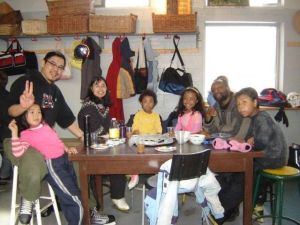
sociable rink clubhouse
We found out, though, by asking around, that a simple concrete block wall could be easily removed. One Saturday in 1996 we got a little group of people together and in 9 hours we chipped out the mortar and took down the interior wall in the rink house, block by block. The city councillor of the time, Mario Silva, persuaded city council to approve funds for four eye-level windows; the grandmother of a young skater donated a new stove to bake cookies; the recreation supervisor scrounged some chairs and tables from city storage rooms, and the rink clubhouse was a reality. Retired Italian and Portuguese construction workers from the neighbourhood could set up (separate) tables and play cards. Rink rats in ever-increasing numbers came in for cookies and bread slices between shinny games. Young parents started bringing their kids. They could watch the older children from the new windows while their toddlers played in the warm clubhouse and ate mini-pizzas. Mothers nursed their babies in a rocking chair we brought in. People caught up on each others’ news. Friendships began.
It turned out that the concrete-block change room with a wall removed was the perfect wintertime meeting place for this jumble of neighbourhood people. Did the architects anticipate the wonderful flexibility of their building? Maybe they did.
History: How buildings can learn and rinks can change
Rink friends and staff used to call the rink house a “shoebox,” because it was so rectangular and plain. Happily, it was not only flexible but also bigger than what was needed. There was room in the garage to store firewood for the bake oven, and the ceiling was so high that Clay and Paper Theatre could hoist their giant puppets up out of the way (but the puppets were still visible when the garage door was open, to the great enjoyment of kids walking by). A provincial “child nutrition” grant allowed the former office and the slop room next to the change room to be adapted, making two halves of a kitchen. The recreation director moved the responsibility for staffing the park programs over to one of his best supervisors, Tino DeCastro, and Tino hired some very good part-time staff.
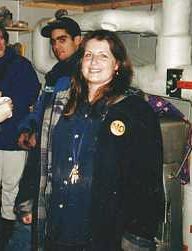
Lily Weston
As word got around about the rink and the clubhouse, little groups of troubled youth from around the neighbourhood got interested in taking their power games to a larger audience. There were youth who had fun “punking off” younger kids for their shoes or their jackets or their lunch money, or who liked threatening the staff, or stealing the clubhouse cookie money. The police didn’t always come when needed, for these minor crimes. So Tino talked to the director and got approval for the Intelligarde security company to provide some backup for trouble calls. A few times when troublesome youths laughed at the rec staff’s request to leave the rink, security staff even brought along a German shepherd on a tight leash. The youth left without further protest. And the message got around: if you want to be included in the lively scene here, don’t mess it up.
After two rink seasons, Tino was able to cancel the Intelligarde contract. And at the end of February 1998, Lily Weston -- the motherly clubhouse staff person Tino had hired – counted up the daily census and realized there had been more than 10,000 visits to the rink over the season.
People began coming from all over the city, and again we found that the rink house could be adapted. Park friends had heard about a city grant program to put more community kitchens into park buildings, and they asked the park program staff to apply. The application was 49 pages long. Three staff spent many hours filling it out. They handed it in 9 minutes before the deadline and, happily, it was approved by city grant staff. The grant was enough to put a second kitchen into an unused corner of the garage. The new kitchen could support a second outdoor wood oven, to be built nearby, and a community dinner on Friday nights. Soon after, the year-round farmers’ market was started.
Urban writer and planning critic Jane Jacobs heard about us, and we learned a bit about her. We found out that she had been writing for years about the ways in which simple, unglamorous, often older buildings can be adapted for new uses when new possibilities arise in a neighbourhood. She said that the more local the new influences were, the better the outcome. And the adapting of the clubhouse was about as local as it gets.
History: Dufferin Rink 2003: the downside of being popular
At Dufferin Rink, as more and more skaters came to play shinny hockey, the rec staff decided to do a better job of enforcing the rules, so that children and skaters still learning shinny, and women’s shinny groups, would have their times to play too. The rec staff also asked ice maintenance workers for better and more reliably-scheduled ice maintenance.
The (mostly male) zamboni staff of that time were used to running the rinks according to their own preference, and some of them got mad about what they regarded as being bossed around by the (mostly female) lower-status, and much lower-paid part-time recreation staff.
It may be that the zamboni staff felt swamped by all the bustle at the rink. Most city rinks were (and continue to be) sparsely-attended a good deal of the time. But Dufferin Rink had a snack bar, and a farmers’ market, and musicians at times, and youth doing cooking and cleaning for court-ordered community service, and rink-side campfires. Park friends were involved in almost every aspect of running the rink. There was no longer an office for zamboni drivers to sit in and read the paper or talk to their friends – the office had become one half of the inside kitchen, and was often full of youthful helpers. And in the garage, there were papier-mâché puppets dangling above the zamboni, and people cooking soup in the new zamboni kitchen, separated only by a glass wall with a sliding door. That meant that even the garage could no longer be a private refuge for zamboni staff between their twice-a-shift trips out onto the ice. This state of affairs was very unpopular with the ice maintenance crew.
Around the same time, the recreation staff also began to think that the rink was getting too crowded. In a city that had, at that time, 51 mechanically-cooled outdoor ice rinks, spread out all over, people were packing their kids in the car and driving clear across town to get to Dufferin Rink. So the Dufferin rink program staff put together a little palm-size rink handbook full of homely, friendly advice and descriptions of what worked for Dufferin Rink. By that time, the mini-pizzas and cookies were bringing in enough extra cash, after the materials were paid for, to cover the printing costs for the booklets, and also to pay staff to visit other city rinks to talk to their colleagues about how they might make their local rinks more popular (and as a side effect, take the pressure off Dufferin Rink). CELOS set up a website, called cityrinks.ca, with a page for every rink, describing how you could get there and what you would find, with photos.
This outreach effort helped and hurt the rink at the same time. People in other neighbourhoods began to lobby the city for improvements at their local rinks, so some of the pressure was off. But when it became known that Dufferin Grove part-time staff had published a booklet and were going around to other rinks – without being directed to do that by management – that won them no friends.
History: Pushback
A bureaucracy of 35,000 city workers is a complicated organism. Decisions taken higher up at city hall can filter down in unpredictable ways. And dissatisfaction at the ground level sometimes makes it up to the top, with radical results.
A week before Christmas 2003, three city staff came to rink. They identified themselves as inspectors from City Hall, and said the rink might have to be shut down because there were so many health and safety infractions. They walked all around during the farmers’ market and ticked off almost everything that went on there – the kitchens, the market, the puppets, the relations between staff and rink friends – as being dangerous and having to stop right away.
That got attention – in the parks and rec general manager’s office, in the new mayor’s office, in the newspapers, in the email connections that were just starting to gain traction in the neighbourhood. After three weeks of back and forth, it turned out that nothing had to be shut down. A park friend made a humorous 10-minute NFB film about the zamboni crisis, as it came to be known, which was a modest hit and is still shown on TV or at documentary festivals from time to time.
But downtown at city hall, some people said they had been disrespected. And the zamboni staff of the time were not happy either. Word spread. The Dufferin Rink recreation staff got a reputation at city hall and among their peers elsewhere in the city for being too embedded with park friends, and for rocking the boat.
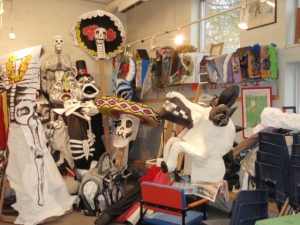
Night of Dread puppets ready in the rink clubhouse
The program staff kept working with park friends anyway, all over the park. More gardens were put in and a drop-in garden club was formed. Clay and Paper Theatre added the spring “Day of Delight” to their yearly Night of Dread parades. Dusk Dances came to the park for a few years, and for five years the Cooking Fire Theatre Festival brought outdoor theatre groups from all over North America. Laura Repo put on a “Little Folk music festival,” and much impromptu music happened too. Tino, the park supervisor, helped set up an NHL PA skate-and-stick donation that got skate lending started. Beginner shinny classes were set up. One summer, over 500 little kids and grownup volunteers worked together under park friend Georgie Donais’ leadership to build the cob café by the playground. Campfires multiplied into the hundreds, and there were weddings, including one where the whole community was invited (and came!).
Rink ice maintenance eventually got better and friendlier. Park food paid for itself with extra left over for new programs and supplies. CELOS got grants to make little films and slide shows about what worked here, and to take them around to other parks.
In 2010, CELOS proposed that the whole operation now be run completely by park staff (the CELOS mandate is only for research into what works, and it seemed like that was done). The rest is history – not a very happy story – and told in other newsletters. Pushback.
Surrounded by tall towers
When your newsletter editor moved into this neighbourhood with her husband and three young children in 1984, the high rises on Dovercourt were already there – rental buildings that were affordable and were often the first places where newcomers got established. Some of the many two and three story houses in the area were boarding houses or were rented to large extended families – Portuguese, Ukrainian, Jamaican, Chinese. And a young family could buy a house here because this was still an unfashionable area, often referred to as “the troubled west end” in the media. Teachers, not paid as well as they are now, could afford to live here, and musicians who also worked as carpenters, and journalists, and plumbers, and actors.
Sometime around 1990, the owners of the Dufferin Mall proposed building an expansion, including a lot of town houses. Most people in this neighbourhood opposed that idea – they were worried that the neighbourhood would be swamped by too many people moving here all at once. Eventually the mall cancelled its building plans anyway.
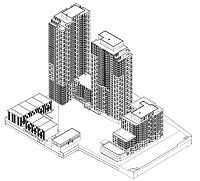
"Davenport village" at Lansdowne/Davenport
More recently, with the ballooning house prices everywhere, the character of the neighbourhood has changed. People who are still here from before feel disoriented by the speed of the changes. Now, tall towers are coming to surround the houses: at Bloor and Dufferin, at Dupont and Dufferin, at Lansdowne and Davenport. In early December the owners of the Dufferin Mall, the Primaris company, announced that they’d like to build some high rises too. According to Emily Paradis, posting on Erella Ganon’s dufferingrovefriends list, “Primaris proposes to build up to four towers on the Dufferin Mall site—of the same height as the proposed buildings to the north at Dufferin and Bloor, which range from 11 to 39 storeys.”
A few weeks after the mall announcement, two people came to the rink clubhouse to meet with this newsletter editor. They wanted to talk about the project, which is named “Dufferin Grove Village.” The people were: Matt Kingston, VP of Development for Primaris, a division of Toronto-based H&R REIT (stands for Real Estate Income Trust) which owns a lot of malls across Canada and the U.S. and some housing in the southern U.S.; and Eric Turcotte, a partner at Urban Strategies, the design company Primaris has hired. Urban Strategies is described as a Toronto-based “global urban design and planning consultancy” on its website.
Eric said he was at the big September 30 park meeting about whether to form a conservancy to run the park. Was he there to prepare for his work on the mall design? Maybe. But he also lives not far away (in a house, not a high rise) and has brought his kids to the park. (One of his colleagues at Urban Strategies is a member of the volunteer “Community Resource Group” that the city put together to talk about ”revitalizing” the northwest corner. He lives near the park and brings his kids there.) Matt from Primaris said that he’s lived in this neighborhood for two years, has often brought his little daughter to the playground, and loves seeing the old metal slides there.
The designers and developers of the high rises are not outsiders. They’re the people who now live in this expensive neighbourhood.
Editorial:
If the “community resource group” (CRG) is anything to go by, there is little agreement among clubhouse/rink-pad users about the rink and clubhouse reno/rebuild. The two bike polo players would like a smaller rink pad. The three skateboarders would like a new slab with smoother concrete. A permit hockey player wants a slightly larger rink pad. The two market reps wants better paths and outdoor spaces for farmers and their customers, more storage space, and more indoor area for the winter market. A few CRG members are themselves designers and are interested in more radical changes, of the kind that can be readily visualized on a screen.
DTAH, the design firm, has emphasized that the clubhouse was not “purpose-built” for its various current uses – and sees this as a central problem. Many of the CRG members seem to accept that idea, while at the same time encouraging the designers to keep flexibility.
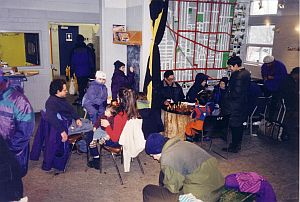
the clubhouse with the wall map
The prospect of thousands of new people moving into the area, as the tall towers get built, seems to lead people into thinking that the clubhouse needs to have more rooms. It’s true that one or two separate “multi-purpose” rooms would allow for rentals for indoor events and birthday parties, or space for a registered children’s program staging area.
But that will mark the end of a community rink clubhouse where all drop-in rink users and their friends can bump up against each other any time of the day or evening, and maybe find new friends.
The $4 million dollars allocated for the “opportunity identified” by the city’s capital projects staff are not for replacing the derelict field house washrooms with a long-asked-for accessible washroom closer to the playground. Those dollars are also not for replacing the muddy or crumbling wheelchair-inaccessible paths throughout the park, or for better water-flow engineering in the sandpit, or for improvements to the cob café. They’re not for kick-starting a conversion of the field house into the “cultural hub and performance space” proposed by Clay and Paper Theatre, after their by-now-24-year residency and in the park. They’re not, in other words, for making the park as a whole work better for the people who use it now, and certainly not for the thousands of new neighbours who will be coming to the park in future – to be outdoors. City Councillor Ana Bailao briefly seemed interested in opening the “$4 million for the whole park” question, but quickly stepped back from it. The remaining possible way to get it back on the table is on Feb.6.
P.S. On January 23, Parks manager Peter White let me tour the rink refrigeration room with two tech services experts. The rusty parts they showed me, and their explanations, made it clear that it’s the right time for new refrigeration machinery. The rink pads, however, are said to be still in good shape.
Editor: Jutta Mason




 Printer friendly version
Printer friendly version
